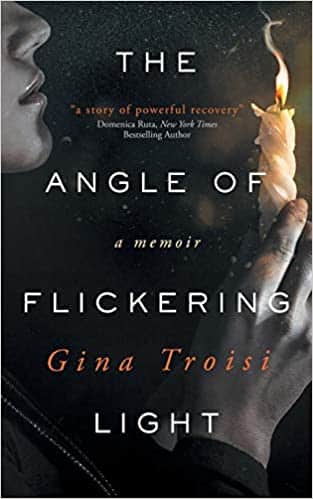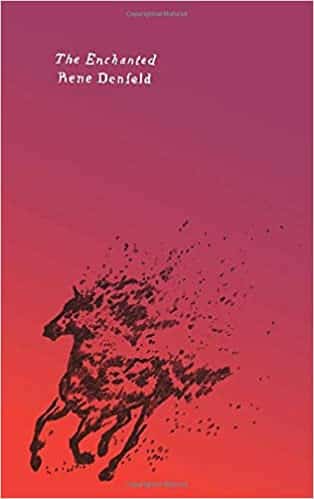Introduction by Sari Fordham
I got to know Gina Troisi because we both had debut memoirs coming out this year of all years. How does one launch one’s book during a pandemic? A group of us had the same question and we decided to join forces and ask it together. Over Zoom we chatted about our jobs, the falling snow (or the orange blossoms), the stories around our books, and how to connect with readers during a pandemic. I was particularly drawn to Troisi and her steady enthusiasm for writing and creative nonfiction. She is originally from New Hampshire and has written a book seeped in place, even as it uncovers the relationships in her lives.
Troisi’s debut memoir The Angle of Flickering Light is an insightful examination of how a childhood of abandonment and abuse spoke into her adulthood and how she learned to navigate the past through narrative. Trosi’s prose is sharp, her structure is unconventional, and her story is one that has stayed with me.
Sari Fordham: What inspired you to write your memoir, The Angle of Flickering Light?
Gina Troisi: I actually didn’t intentionally set out to write a memoir—at least not at first. When I began working on my MFA in 2007, I had one goal in mind: to improve my craft, and to ultimately become a better writer. Writing has always been the way I’ve processed, the way I’ve made meaning of what has happened, so I began writing personal essays—examining situations, events, and circumstances that had been instrumental in shaping the person I had become.
As I completed these essays, many of my mentors and peers continued to point out that I was returning to the same themes and subjects, as well as the same characters and settings. Even though I was working on disparate pieces, it became undeniable that the essays made up a larger body of work, with an overarching narrative.
Through writing, I was asking personal questions, but they were naturally becoming universal. Some of these questions were about despair and loneliness, but I was also weaving ideas about hope and perseverance throughout.
SF: Your memoir begins with this striking scene where you’re five years old and playing with your father’s novelty pens. The pens have women on them and when you turn them upside down, their clothes come down. Did the book always begin there for you?
GT: No. I experimented with multiple beginnings. In fact, at one point that first scene came way later, in the last third of the book.
While thinking about structure, I spent much time contemplating what I wanted to illuminate as the core of the memoir—the narrative through-line that the reader could follow, but which would also allow me the freedom to veer off into the past or future with ease, in order to illustrate the heart of the story.
But when I was revising, , I realized that it would make the most sense to begin the book with my father having just moved out on his own, which was not only one of my earliest childhood memories, but also where the conflict began.
SF: I’m really interested in how imposing a structure onto a story can open up a narrative. Your memoir is divided into three parts. How did using defined sections, which feels like a compartmentalizing tool, allow you to create that through-line?
GT: It absolutely was a compartmentalizing tool. That’s a great way to describe it. It allowed me to see the larger shifts of the narrator’s story, and to summarize her transitions in a neat way, by including titles for each of the three parts. In reality, the transitions were not neat; they were chaotic and erratic, but the division and labeling of the sections allowed me to gain even more distance—to really step back and assess what each part of the story was about.
SF: I admire how your book moves with such ease through time. By considering two different memories together, you added in layers of depth. How did you discover the shape of your chapters?
GT: At first, this felt tricky, since the memoir covers such a wide span of time; there are scenes when the narrator is five years old, and there are scenes when she is thirty-five. But once I had defined the heart of the story, the shape of the chapters became pretty instinctual and organic.
As you mentioned, I divided the book into three sections, which helped my focus. I decided to begin with prominent childhood years and scenes that would show the way the narrator had been molded, followed by a second part detailing young adult years that would exemplify the different ways in which she becomes lost and stuck, and I ended the book with a third, more reflective section, where I was able to integrate more of the present-day adult narrative voice—questioning, contemplating, and dealing with the aftermath of events and choices. This three-part division helped to clarify the shape of the chapters—where they needed to begin and end, and how they needed to be framed in order to highlight the core of the narrative.
SF: There is a really memorable scene in your book where you’re on a research trip for your memoir and you discover that a story you were told as a teen might have been completely fabricated. Were there other surprises as you were researching or writing?
GT: There were many surprises, yes, but not as dramatic as the one you mention, where the research almost completely changed the reality of what I had believed.
Most of the surprises had to do more with self-revelation rather than discovering a false truth. I have found that, in order to write memoir, we need to first have a heightened sense of self-awareness. But even when we have done a tremendous amount of work on ourselves, and when we think we understand circumstances fully, there is always more to learn. We have so many different versions of ourselves. And of course, as we work on a project, we are also aging and changing, and our perspectives tend to revise themselves. Through the act of researching and writing, I often realized I needed to do more digging in the way of self-discovery.
SF: How did being open to self-discovery influence the book you were writing?
GT: Being open allowed me to let the book and the material take its own shape, in a sense. It provoked me to question my understanding of the way things happened—how and why—and to challenge my own perceptions and beliefs. It prompted me to be as honest as possible on the page, even when I was still actively trying to figure things out, and to dig deeper, even if I already believed I’d excavated all that I needed to. And it prompted me to explore the fallibility of memory.
SF: As a reader, I was drawn to the authenticity of your voice and your vulnerability. As a writer, that’s a hard place to stay for an extended period of time. Did you feel protective of your younger self? How did you remain open?
GT: I don’t know if I felt protective exactly. In order to write this memoir, I had to become pretty removed and detached, and to really see myself as a character rather than a version of myself. Which of course, took a lot of self-work over a period of years.
When I received feedback on earlier drafts of the book, a few people pointed out that the narrator wasn’t self-aware enough—that the reader couldn’t make sense of her choices, of her self-destructive decisions, and in turn couldn’t always empathize with her. So I realized that it was going to be important to show the way she’d been shaped from a young age, even if it felt vulnerable at times. I knew that I needed to show her raw interiority, and that I owed that to the reader.
SF: In the chapter Cleaning House, you write: “California was a place where I stepped out of time. I attempted to transform myself into someone who I was not, at least not yet—someone who rested and reflected, someone who paused to make sense of her choices.” I love these lines because they speak to the journey you were on and gesture to who you were becoming. They also reflect the importance place plays in your memoir. Whether the place is an apartment, a playground, a city, or a state, you’re attentive to where you are and how you are shaped by it. How did you reinhabit those places while you were writing? Did you look at pictures? Visit them? Take notes? Listen to music?
GT: I actually did all of the above. I revisited old journals and letters and photos, listened to music that was etched into my brain from various moments and timeframes in the book. I did visit places, especially when I could drive to them—houses and apartments and restaurants where I worked.
When I wrote about Santa Cruz, California where I lived for a short time in 2002, but which was a pivotal time both in life and in the book, I flew out there from Boston and stayed in a cheap motel for four days. I revisited the places where I spent time when I lived there so long ago; I ran the same roads alongside the ocean, went to bookstores and coffeeshops and bars—even the grocery store where I’d bought my food. And it helped to uncover the memories in a crucial way. I love thinking about place in all aspects of writing, no matter which genre I’m writing in. I’m fascinated by the way a place can become as essential as any other character.
SF: What books inspired you while you were writing this one?
GT: Oh gosh, so many. Cheryl Strayed’s Wild, Sue William Silverman’s Love Sick, Fleda Brown’s Driving With Dvorak, Tim Hillegonds’s The Distance Between, Randal O’Wain’s The Meander Belt, Abigail Thomas’s Safekeeping, Joan Didion’s The Year of Magical Thinking.
Lidia Yuknavitch’s The Chronology of Water was a particularly strong influence. Before I knew of Yuknavitch or her work, I saw her speak at an AWP conference in Seattle, where she was part of a panel of authors who’d written non-chronological memoirs. I’d been wrestling with the structure of my book–with how to shape what was then an essay collection into a memoir, and I was resisting telling the story from beginning to end; I just knew it wasn’t the right direction for my material, but I couldn’t fathom how to do it any other way. Lidia, in the most passionate, lovely voice, said, “I believe in art the way other people believe in God.” She had me right there. And then she went on to describe the process of shaping her memoir. After the seminar, I immediately bought The Chronology of Water. I read and reread it, and thought about deeply about the structure of my own book. It not only inspired me, but it gave me the liberty to think about how I might break the rules when it came to structure–it opened me up to the possibilities available, and assured me that I did not have to be boxed in by narrative convention. It was a true gift.
Sari Fordham’s work has appeared in Brevity, Green Mountains Review, The Chattahoochee Review, Passages North, among others. Her memoir Wait for God to Notice is available from Etruscan Press. She lives in California with her husband and daughter.
Gina Troisi received an MFA in creative nonfiction from The University of Maine’s Stonecoast MFA Program in 2009. Her work has appeared in numerous literary journals and anthologies, including Fourth Genre, The Gettysburg Review, Fugue, Under the Sun, Flyway: Journal of Writing and Environment, and elsewhere. Her debut memoir, The Angle of Flickering Light is available from Vine Leaves Press. She is currently working on a novel-in-stories.
~~~~~~~~~~~~~~~~~~~~~~~~~~~
Margaret Attwood swooned over The Child Finder and The Butterfly Girl, but Enchanted is the novel that we keep going back to. The world of Enchanted is magical, mysterious, and perilous. The place itself is an old stone prison and the story is raw and beautiful. We are big fans of Rene Denfeld. Her advocacy and her creativity are inspiring. Check out our Rene Denfeld Archive.
Order the book from Amazon or Bookshop.org
~~~~~~~~~~~~~~~~~~~~~~~~~~~
Anti-racist resources, because silence is not an option
~~~~~~~~~~~~~~~~~~~~~~~~~~~




